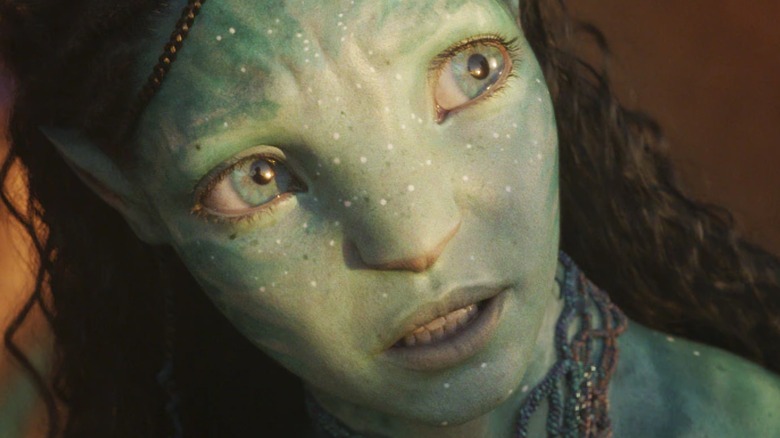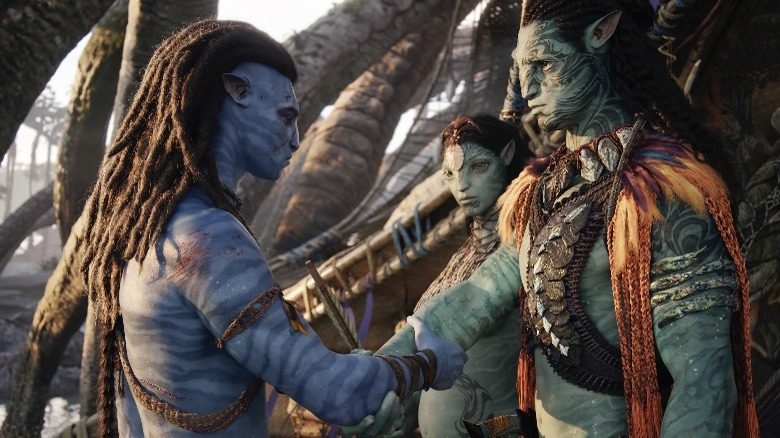Avatar 2's Stunning Costumes Were A Result Of Over 200 Hours Of Crafting
One of the most immediately noticeable details filmgoers can pick up on in James Cameron's films is the look of the production. The art direction, set decoration, hairstyling, and character costumes are typically distinctive and eye-catching. This can be seen in the drab, dark military outfits of 1986's "Aliens" or the lush, early 20th-century aristocratic and commoner outfits that fill the screen in 1997's "Titanic." The director himself has a streak of perfectionism that regularly sees the "True Lies" creator overseeing every aspect of one of his movies, up to and including design work (via Vulture). But Cameron's sense of ingenuity in creating his vision, combined with the work of returning costume designers such as Deborah Lynn Scott, can be breathtaking to behold.
The costume design of "Avatar: The Way of Water" is a perfect example of this. Scott returned to work on the outfits, aesthetic accessories, and allure of the Na'vi in the sequel film after her efforts on the first feature in the series and "Titanic." Viewing the ornate and distinctive costumes in the new movie is a remarkable sight, thanks to the imaginative efforts of Deborah Lynn Scott, her team, and the director. Even more awe-inspiring is the fact that many of the outfits in the movie resulted from over 200 hours of intense crafting and designing. Here are the details.
Costume designer Deborah Lynn Scott says the movie's costumes were physically created first instead of drawn
Deborah Lynn Scott is a film costume designer with over 50 movie design credits to her resume, including an Academy Award win for best costume design for "Titanic" in 1998 (per IMDb). That film's outfits were tailored to a specific period, chiefly 1912 Europe, but her work on both "Avatar" and its sequel allowed the designer to think outside the box. In a joint interview with the director for Variety, Scott was asked if the tech had evolved for designing the character looks for the new film from the first feature. The designer answered by pointing out the importance of handcrafting outfits first instead of drawing out their ideas and working from there.
She then shared how the costumes were so intricate in their design that they were "like a texture map unto itself" before revealing how physically crafting the clothes allowed for more innovation over illustrating. The costume designer later added, "There was a lot of water testing. We did it in Wellington, New Zealand, and all over the city. We had to look at hair simulation and how curly or braided hair would look as it went from dry to wet to dry with the drips coming off." Scott further elaborated on how experimenting with various fibers was essential to ensure buoyancy was achieved for the numerous underwater scenes.
When factoring in research time, each of the movie's costumes took over 200 hours to design
"Avatar: The Way of Water's" towering achievements in visual spectacle, storytelling, and numerous areas of design showcase James Cameron's painstaking innovation to great effect. But his penchant for perfection can sometimes reveal staggering statistics in terms of budget, filmmaking norms, and certainly time.
When asked by Variety how long it took to build a single costume for the sequel, Deborah Lynn Scott said, "Depends on the costume. It started with a lot of research and development that goes into it. But what did the character and scene dictate to me and to Jim? We followed a lot of the template of the first movie and took it to a higher and more complicated standard."
Scott then pointed out how a single costume for the Na'vi took 200 hours to create, which is five weeks of regular work based on a 40-hour work week. But even more surprising was the costume designer's revelation that this number did not include all of the research that went into imagining and accurately representing the outfits the residents of Pandora would wear based on their own unique customs. In terms of the tech involved in the film vs. handcrafting, she added, "We found that all this magic of 3D printing, which we did in some cases to augment, wasn't as good as what was real, handcrafted, sculpted by hand and individual bespoke pieces."


